|
PART 3
|
|
|
.44 Caliber Percussion Revolver
|
|
|
As reviewed in Part 1 and 2, Ebanezer (Eban) Townsend Starr of
Yonkers, New York patented and manufactured 3 types of percussion
revolvers that were purchased by the United States Government
starting in 1861 and ending in 1864. 6,352 Starr DA Navy and Army
revolvers were purchased on the open market and 41,102, including
the SA Army, were purchased under contract for a total of 47,454
guns. The Starr DA Army accounted for approximately 23,000 of
the total. It is believed that both the DA and SA Starr Army revolvers
shared the same serial number range with the numbering for the
SA's starting off where the numbering for the DA Army stopped.
The DA Navy had it's own serial number range. Starr revolvers
were the third highest in number to be purchased by the Union
government. All three of these models are pictured below.
|
|
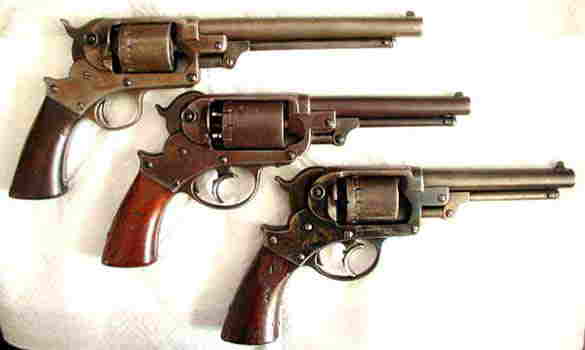
From Top To Bottom Starr
Model 1863 Single Action .44 Caliber Percussion Army Revolver
(1863-1864
|
|
|
|
|
|
The Model 1863 Single Action .44 caliber Percussion Army Revolver
was the third of the Starr revolvers produced for the military.
Between September, 1863 and December 22, 1864, the Starr Arms
Company delivered 25,002 Model 1863 Army revolvers to the Ordnance
Department. The government's cost for this simplified, more conventional
arm was $12.00 each - less than half that of the DA Army Model
which were sold at $25.00 each. These arms and components were
produced in Starr's plants in Yonkers, Binghamton and Moorisania.
Their office and sales outlets were in New York City. All in all,
about 31,000 Model 1863's were manufactured.
|
|

Right Side View of The Model 1863 Single Action .44 Caliber Percussion Army Revolver
|
|
|
|
|
|
This revolver, with it's simple single action mechanism, operated
the same way as the Colts, Remingtons and Whitneys of the day
and was competitive in pricing with them. The complex and expensive
Starr double action revolver was replaced by the need for economy
and market driven pricing.
|
|
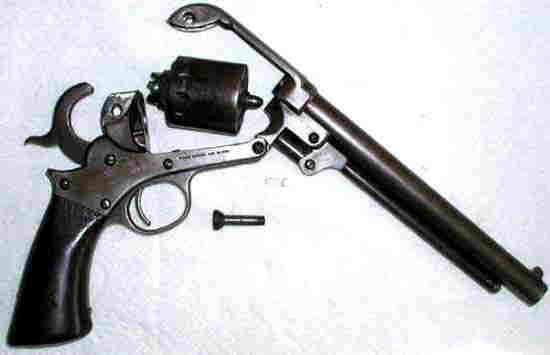
Right Side View of The Starr SA Army, Cocked with Frame Open - Hinge Screw and Cylinder Removed
|
|
|
The blued hinged barrel is 7-5/16 inches long and marked with
a small "C" on the right side towards the rear of the barrel and
the remains of another small letter at the barrel's left rear
side. It is rifled with 6 grooves. The mortised iron front sight
base is 3/16" from the muzzle with the "V" notch in the hammer
lip serving as the rear sight. The loading lever is cased hardened
and is secured by a spring actuated plunger. The rounded lever
catch is 13/16" from the muzzle. The two-piece blued frame is
held together by a round knurled thumb screw which enters from
the right side between the recoil shield and hammer. The frame
is stamped on the outside beneath the cylinder with the address
on the left frame and the patent date on the right frame. This
is opposite of the stampings on the Navy Model. The SA Army frame
is also stamped with a small "C" above and below the front frame
hinge screw on the left side. A small "V" is stamped at the bottom
front of the frame where it turns up towards the front frame serial
number.
|
|

"C" Stampings - Right Rear Frame
|
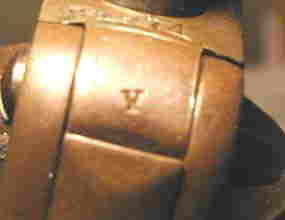
"V" Stamp Bottom Front of Frame
|

Left
Frame Marking
|
|

Right
Frame Marking
|
|
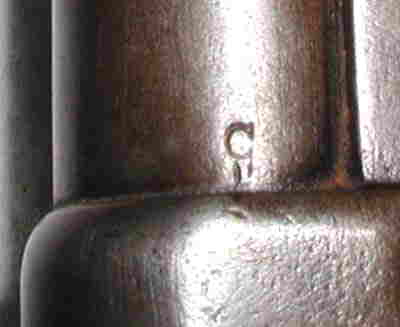
"C" Stamp, Right Rear Barrel
|
|
|
|
|
|
The loading groove above the hinge screw at the lower front of
the rounded frame has a heavier bevel than the SA Army model (see
Part Two). The recoil shield includes a short capping channel
cut through the groove. The separate, blued backstrap is held
to the frame by the rearmost frame screw, while the front strap
is integral with the small oval trigger guard. The hammer spur
is longer than that of either the DA Navy or Army models. It is
case-hardened. The one-piece walnut grips are oil-finished. The
grip is rounded at the bottom and is without a butt strap. The
weapon measures 14¾" overall and weighs 3 pounds. The partially
exposed nipples are parallel to the axis of the chambers.
|
|
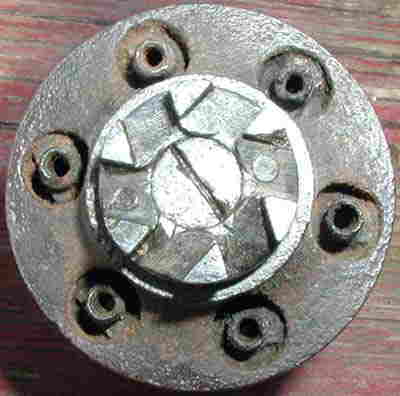
Rear View Of Cylinder
|
|
|
|
|
|
The 1-7/8" inch, six-shot, .44 caliber blued cylinder is marked
with the serial number "25974" and a small "R". The oval stop
slots are supplemented by intermediate safety slots of the same
shape.
|
|
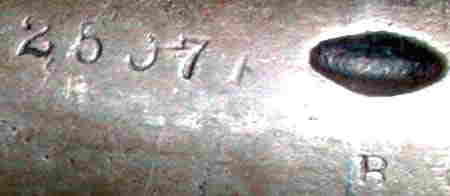
Close Up of Cylinder Serial Number "25974" And "R" on Cylinder And Oval Cylinder Stop
|
|
|
|
|
|
The serial number will also be seen at the front bottom of the
frame, on the hammer rest and on the bottom of the barrel at the
forward most frame screw. The latter stamping is difficult to
see and has not been photographed. Normally, only the first digit
or two can be seen without taking the arm apart. Unlike the Navy
and Army Double Action Revolvers (See Parts 1 and 2), there is
no serial number stampings on the inside of the hammer shank.
|
|
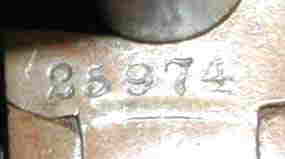
Serial Number "25974" at Front Bottom of Frame
|
|

Serial Number "25974" Stamping - Hammer Rest
|
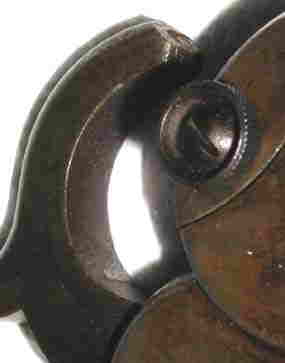
Note Lack of Serial Number Stamping Inside of Hammer Shank
|
|
|
|
|
The inspector cartouches are no longer visible on this arm. What
is left is very, very faint.... only a hint that they were once
there.
|
|
|
|
|
|
|
|
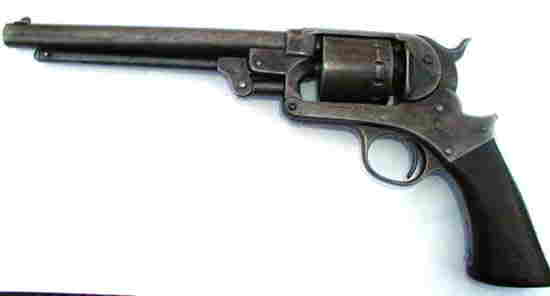
Left Side View Of The Starr Model 1863 Single Action Revolver
|
|
|
|
|
|
The reference material and some wording for this posting came
from Robert M. Reilly and his book "U.S. SMALL ARMS 1816 - 1865".
Also utilized was Norm Flayderman's FLAYDERMAN'S GUIDE(S) TO ANTIQUE
AMERICAN FIREARMS.... AND THEIR VALUES."
|
|
| Again, my son and webmaster, Reed Radcliffe, processed this data to my (our) web page. | |
| Dave
Radcliffe
|
|